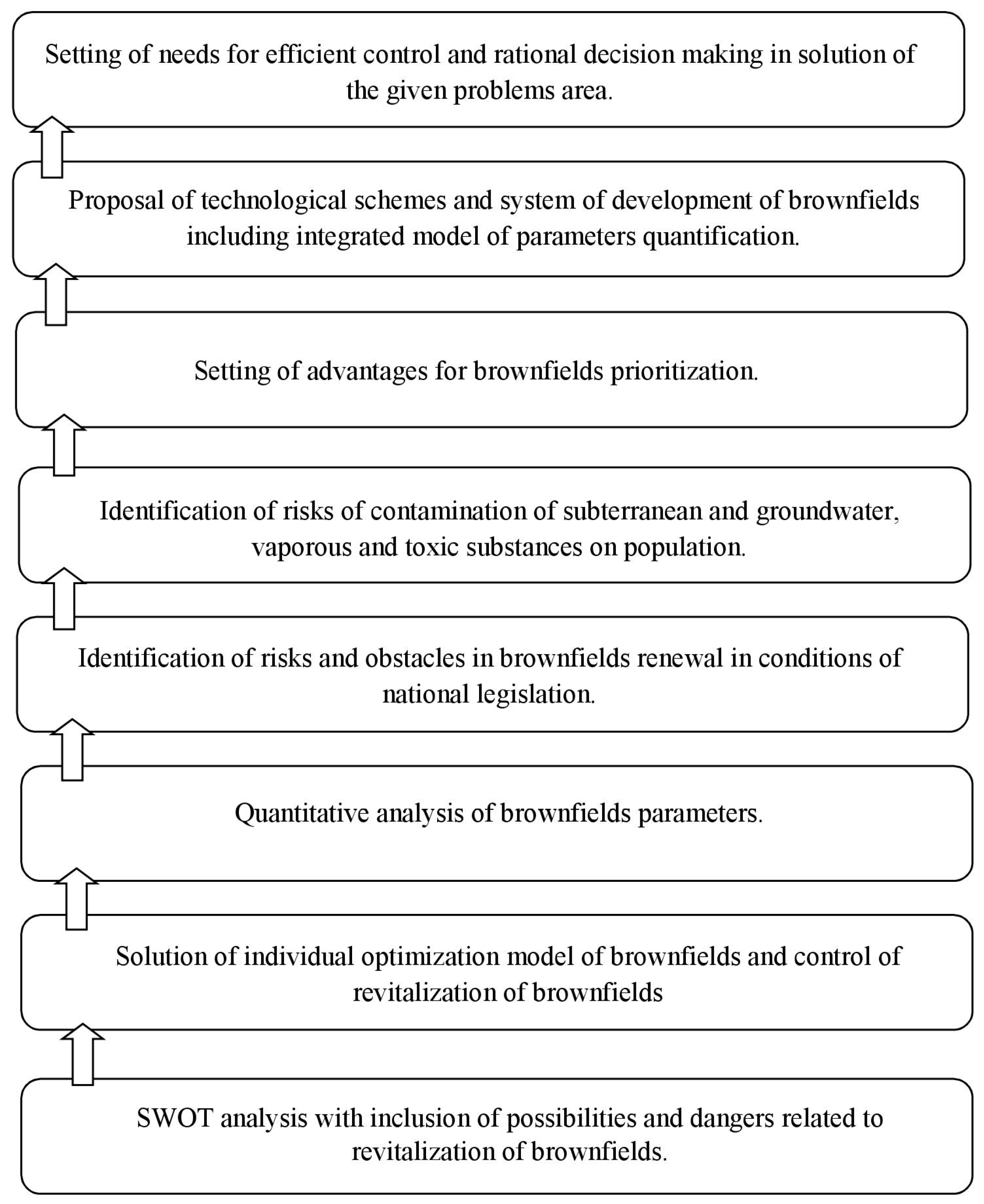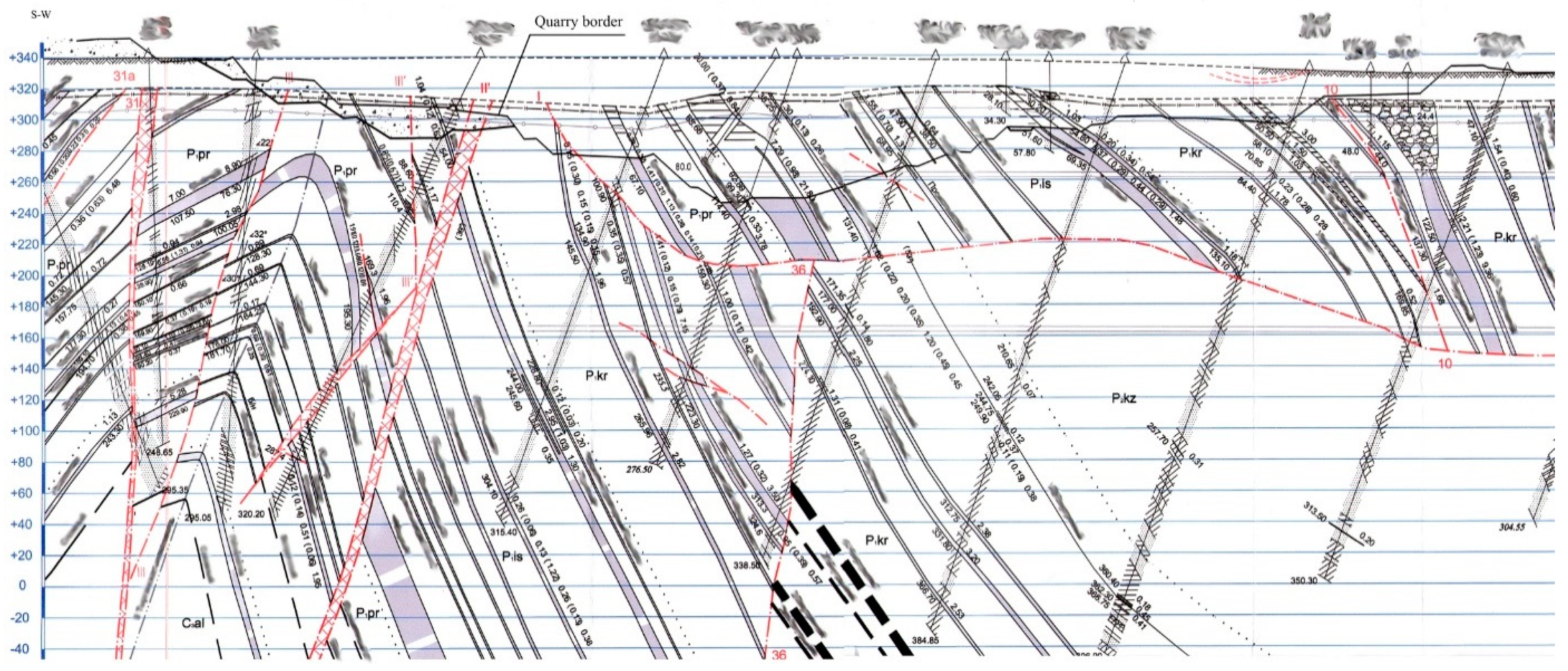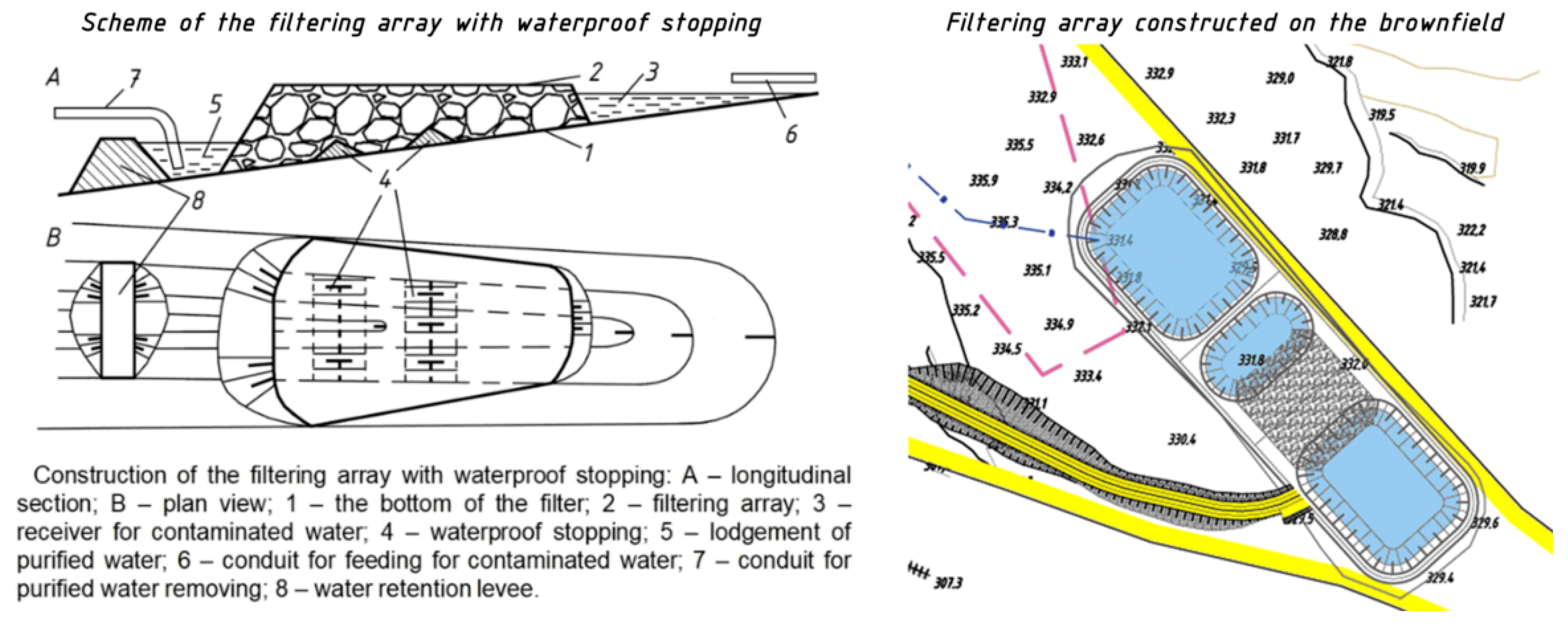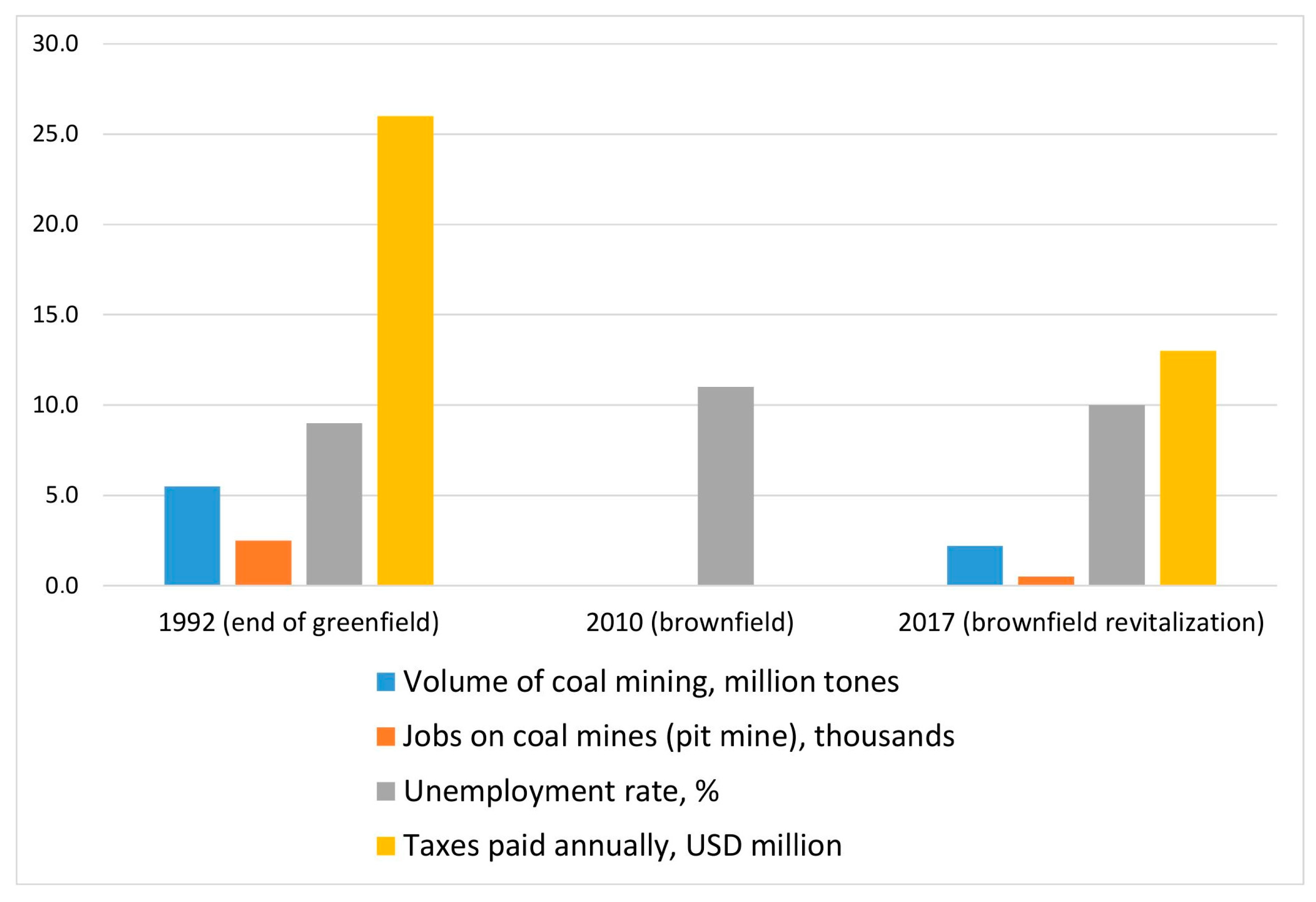Mine Sited after Mine Activity: The Brownfields Methodology and Kuzbass Coal Mining Case
Abstract
:1. Introduction
- Advantageously localized: market alone will take care of such brownfields. Public non-financial interference can increase advantages of the local community.
- Less advantageously localized: development of such brownfields needs a public intervention or inclusion of public financial resources that will pay for the expenses breach.
- Non-commercial localities: development of such brownfields observes mainly social aims or preservation of the living environment.
- Emergency state: this is realty, dangerous for health or environment. If there is no responsible entity for the contamination, removal has to be done from public resources [12].
2. Methodology for Revitalization and Prioritization of Brownfields
2.1. Main Aims of the Proposal
- Evaluation of the actual state of brownfields from the legislative, economic and environmental point of view.
- Design, vision, mission and strategic aims of brownfields revitalization.
- Design of optimization model of quantification parameters of brownfields revitalization.
- Development of strategic alternatives of brownfields revitalization.
- Revitalization of brownfields for future industrial and non-industrial use;
- Development of educational system in the area of brownfields revitalization and securing of professionalization of public administration within this area;
- Maximal inclusion of accessible European resources for revitalization of brownfields.
- Systematic problem solution for the highest number of brownfields;
- Decrease in brownfields number and taking of agricultural land for new building in accordance with principles of permanently sustainable development;
- Prevention of creation of brownfields;
- Increase in quality of urban environment and increase of competitiveness of cities and villages;
- Aimed and efficient use of public means for support of brownfields revitalization, where the public action is needed and reasonable;
- Implementation of application of the best work by realization of projects of revitalization of brownfields, support of professional control of revitalization;
- Increase in quality of living environment and removal of old ecological burdens in brownfields localities.
2.2. Implementation of Methodology
2.3. The Results of Proposed Methodology
- Improvement in business environment;
- Aimed and efficient use of accessible financial resources;
- Mobilization of private capital and obtaining multiplication effects; and
- Expansion of special knowledge and exchanging of international practice and education support.
- Decrease in number of brownfields and taking of agricultural land for building on green fields;
- Evaluation of realty on the areas of brownfields and their surroundings;
- Improvement in the living environment by removal of old ecological burdens;
- Increase in cities attractiveness and increase in travel business;
- Creation of new jobs;
- Increase of economic activities in the regenerated area - business and competitiveness;
- Inflow of direct international investments;
- Progressive lowering of regional disparities; and
- Better image of the Slovak republic.
- Absence of national coordination unit;
- Poor coordination of activities between individual ministries;
- Insufficient cooperation on the vertical level; and
- Insufficient cooperation between separate institutions and their offices.
- Absence of national strategy to approach this problem area;
- Absence of a unified register of localities and their critical parameters;
- Absence of analytic tools and approaches for setting of priority investments into localities; and
- No flexible planning tools;
- Insufficient financial resources;
- Obstacles in cooperation of the public and private sector.
2.4. Environmental Insurance as a New Tool and Its Contribution
- Environmental insurance (EI) has the potential to reduce the uncertainties associated with brownfield redevelopment projects. EI policies that limit clean-up cost exposures provide a strong basis for the quantification of risk that is often demanded by lending institutions as a condition for investment [16].
- Private sector demand for EI is growing rapidly in the European Union, and speculative redevelopment of even heavily contaminated sites is now being undertaken by venture capital pools using the insurance coverage as a risk management and loss prevention tool [17].
- While public sector experience is limited, there are some examples of creative use of environmental insurance coverage by municipalities and states to stimulate brownfield redevelopment and reuse [3].
- Municipal governments and other local economic and community development organizations can promote urban redevelopment on difficult-to-regenerate small sites through their ability to create pools of potential projects that could be covered by a common environmental insurance policy [1].
- Municipal governments and other local economic and community development organizations could make a significant contribution to more systematic examination of environmental insurance and its potential value as an urban redevelopment tool through increasing local public sector awareness of the changes in EI products, services, availability and costs [18]. The Department could develop the capacity to provide the information needed by utilizing its extensive communications with local governments and agencies that apply for and/or receive grants for their urban redevelopment efforts [19].
- How does municipality or metropolitan area size affect the value that insurance can provide to brownfield sites?
- Does environment insurance make a difference by providing access to capital that would not otherwise be available?
- How does the role of environmental insurance change with the strength of the local mineral resource market?
3. Case Study: Kuzbass Coal Mining
- Ecological advantages: the return of deposit segment to exploitation without involvement of additional land; restoration of the drainage and wastewater purifying, which prevents further contamination of local rivers by products of leaching.
- Economic advantages: the maintenance of mining activity in the district. If before the 1990s in this brownfield there were five mines with more than 9000 employees (of which more than 6000 were underground workers), then by the time of mines ”closure (late 1990s)” about 2500 people (1600 underground workers). In the event of a complete cessation of coal mining in the area all of them would be fired. Therefore, the construction of coal open pit mine on the site of brownfield allowed saving 580 jobs, 410 of which were occupied by former workers of closed underground mines (Figure 4).
- 3.
- Perspective development: the transition from underground coal mining to open pit mining ensures safer mining operations and virtually eliminates fatal accidents.
4. Conclusions
Author Contributions
Funding
Acknowledgments
Conflicts of Interest
References
- Cehlár, M.; Šimková, Z. State of Approaches to Evaluation of Mineral Deposits. Econ. Innov. Manag. 2017, 52–65. [Google Scholar] [CrossRef]
- Pavolová, H.; Cehlár, M.; Soušek, R. Vplyv Antropogénnych Činností na Kvalitu Životného Prostredia; Institut Jana Pernera: Pardubice, Czech Republic, 2012. (In Slovak) [Google Scholar]
- Pavolová, H.; Domaracká, L.; Mitterpachová, N. The Impact of Environmental Burden on the Reuse of Brownfields in Slovakia; Univerisities of Košice Publishing: Košice, Slovakia, 2009. [Google Scholar]
- Gasanov, E.A.; Gasanov, M.A. Innovative Development of Russian Arctic. Econ. Innov. Manag. 2017, 30–38. [Google Scholar] [CrossRef]
- Golofastova, N.N.; Mikhailov, V.G.; Seredyuk, I.V. Transformation of ecological-economic system of coal mining region. Econ. Innov. Manag. 2017, 66–75. [Google Scholar] [CrossRef]
- Litvin, O.; Tyulenev, M.; Zhironkin, S.; Prokopenko, S. Methodology of coal losses calculation at open pit mining for complex geological conditions—Review. Acta Montan. Slov. 2017, 22, 146–152. [Google Scholar]
- Banzhaf, S.; McCormick, E. Moving beyond Cleanup: Identifying the Crucibles of Environmental Gentrification; National Center for Environmental Economics: Washington, DC, USA, 2007. Available online: https://www.epa.gov/environmental-economics/working-paper-moving-beyond-cleanup-identifying-crucibles-environmental (accessed on 10 October 2018).
- Environmental Protection Agency (EPA). Brownfields Assessment Grants FactSheet; Environmental Protection Agency: Washington, DC, USA, 2009. [Google Scholar]
- Hollander, J.; Kirkwood, N.; Gold, J. Principles of Brownfield Regeneration: Cleanup, Design, and Reuse of Derelict Land; Island Press: Washington, DC, USA, 2010. [Google Scholar]
- Fisher, B.H. Brownfields Redevelopment and Gentrification: A Socio-Economic Evaluation of the EPA Brownfields Pilot Program; Iowa State University: Ames, IA, USA, 2011. [Google Scholar]
- Holmanová, A. Brownfields in the Rural Landscape; Land Plans: Kosice, Slovakia, 2017; Available online: http://www.uzemneplany.sk/zakon/brownfieldy-vo-vidieckej-krajine (accessed on 10 October 2018).
- Ferber, U. Brownfields Handbook, Lifelong Educational Project on Brownfields; Tech. Rep. Leonardo Da Vinci Pilot Project CZ /04/B/F/PP-168014; Silezian University: Gliwice, Poland, 2006. [Google Scholar]
- U.S. EPA (United States Environmental Protection Agency). Potential Insurance Products for Brownfields; U.S. EPA: Washington, DC, USA, 1996.
- Walker, C.; Boxall, P.; Bartsch, C.; Collaton, E.; Meyer, P.B.; Yount, K.R. The Impact of Environmental Hazards and Regulations on Urban Redevelopment; Northern Kentucky University: Washington, DC, USA, 1997. [Google Scholar]
- Kretschmann, J.; Efremenkov, A.B.; Khoreshok, A.A. From Mining to Post-Mining: The Sustainable Development Strategy of the German Hard Coal Mining Industry; IOP Conf. Series: Earth and Environmental Science; IOP Publishing: Bristol, UK, 2017; Volume 50, p. 012024. [Google Scholar]
- Cehlár, M.; Domaracká, L.; Šimko, I.; Puzder, M. Mineral Resource Extraction and Its Political Risks; Environmental Science, Policy and Management (ESPM) Workshop: Tatranská Štrba, Slovak, 2015. [Google Scholar]
- Pavolová, H.; Domaracká, L.; Mitterpachová, N. The Impact of Environmental Burden on the Reuse of Brownfields in Slovakia, 2nd ed.; Univerisities of Košice Publishing: Košice, Slovakia, 2015. [Google Scholar]
- Cehlár, M.; Kuzevic, S. Environmental Insurance for Brownfields Redevelopment Activities and Feasibility Study as Basic Part of Complex Solution. Acta Montan. Slov. 2004, 9, 5–8. [Google Scholar]
- Cehlar, M.; Vodzinsky, V. New Approach to the Basic Evaluation of Raw Material Resources in Market Economy. Acta Montan. Slov. 2001, 6, 42–55. [Google Scholar]
- Tyulenev, M.A.; Zhironkin, S.A.; Litvin, O.I.; Tyuleneva, E.A.; Zhironkina, O.V.; Markov, S.O. Safe and Productive Application of Hydraulic Backhoes in Coal-Bearing Areas of Complex Structured Deposits. Geotech. Geol. Eng. 2017, 35, 2065–2077. [Google Scholar] [CrossRef]
- Vaneev, A.V. Opening-Up Scheme with Transport Jumpers to Reduce the Overburden and Coal Transportation Distance at Arshanovsky Open Pit: Case Study. J. Min. Geotech. Eng. 2018, 2, 13–35. [Google Scholar] [CrossRef]
- Kolesnikov, V.F.; Cehlar, M.; Tyuleneva, E. Overview of excavation and loading operations in the coal-bearing zones at Kuzbass open pit mines. J. Min. Geotech. Eng. 2018, 2, 36–49. [Google Scholar] [CrossRef]
- Katsubin, A.V.; Makridin, E.V. Systematization of the technological schemes of excavator faces at the central Kuzbass open pit mines. J. Min. Geotech. Eng. 2018, 1, 81–88. [Google Scholar] [CrossRef]





| Basic Data | Settings | Case Described |
| Town (city) | Kiselevsk City | |
| District | Kemerovo region | |
| County | Russia | |
| Total population of municipality (city) | 91,000 | |
| Area of municipality (city) in m2 | 162,000,000 | |
| Population density at 1 m2 | 0.0006 | |
| Movement of the population | Population growth | - |
| Stagnant population | - | |
| Population decline | −13,000 for 2007–2017 | |
| The relation of the municipality to the main transport infrastructure (distance in km) | Highway | - |
| Way of 1st class | 14 | |
| Main railway line | 1 | |
| Airport | 25 | |
| Facilities of the village | Electricity | Yes |
| Gas | Yes | |
| Water | Yes | |
| Canalization | Yes | |
| Socio-economic situation of the municipality | ||
| Indicator of the debt of the municipality (city) | High (>35%) | - |
| Medium (15–35%) | Yes | |
| Low (<15%) | - | |
| Registered unemployment rate in % | In the town (in the town) | 11 |
| In the district | 8 | |
| In the county | 6.2 | |
| Structure of population (city) in % | Pre-productive age | 17 |
| Productive age | 21 | |
| Post-productive age | 62 | |
| Indicators of the total utilization of the territory of the municipality | ||
| State of the planning documentation | Negotiated and approved in the year | - |
| Updating (end date) | 2011 | |
| Top Investors (Provide Name) | In the town (in the town) | JSC Kiselevsk City Coal Company |
| In the district | JSC KuzbassRazrezUgol | |
| In the county | JSC UGMK | |
| Basic data on brownfield | ||
| Location of brownfields | ||
| Address of location of brownfields | Company | Kiselevsk City Coal Open Pit Mine |
| Location | Quarry field in 1.4 km to Kiselevsk City | |
| Cadastral area | ||
| Area of brownfields in m2 | 35,400,000 | |
| Ownership structure (please include a list of owners in the annex, or contact details for the owners) | State | - |
| Community | - | |
| Domestic private owner | - | |
| Foreign private owner | - | |
| A cooperative of owners | Yes | |
| Other entity | - | |
| Unknown | - | |
| Property-legal relations (please attach: cadastral map-copies of ownership sheets) | Simple ownership relationships | Yes |
| Multiple owners acting in concert | - | |
| Multiple owners acting unattended | - | |
| Current state of brownfield | ||
| Status of abandoned and unused brownfield | Brownfield is completely abandoned and unused | - |
| Brownfield is partially abandoned and unused | Yes | |
| Brownfield is used inappropriately | - | |
| Current state of the brownfield | Relatively good | - |
| Bad | Yes | |
| Emergency | - | |
| Brownfield equipment | Electricity | Yes |
| Gas | No | |
| Water | Yes | |
| Canalization | Yes | |
| Age brownfield | Up to 5 years | - |
| 5 to 15 years | - | |
| Over 15 years | Yes | |
| The nature of the previous use in terms of contamination | Without contamination-non-hazardous, mild | - |
| Contamination-moderate risk | Yes | |
| Contamination-high risk | - | |
| Identification of the brownfield site in terms of the importance of the urban or landscape element | Yes/No | Yes |
| Location of the brownfield site in the flood area | Yes | Technogenic |
| No | Natural | |
| Ecological audit (if yes, please specify) | Yes/No | Yes (water, air, seismic) |
| Survey of contamination (if yes, please specify) | Yes | water, air pollution with suspended material, aerosols |
| No | - | |
| Pollution risk analysis (if yes, please specify) | Yes | High for water contamination |
| No | - | |
| Original purpose brownfield | ||
| Brownfields categories: | Industrial buildings | - |
| Army objects | - | |
| Abandoned or inappropriately used agricultural objects | - | |
| Former quarry areas—quarries, mines | Yes | |
| Former outlets or operations | - | |
| Unused land plots | - | |
| Uninhabited blocks of residential homes | - | |
| Other | ||
| Original use of brownfields—the previous industry (if the name of the business is also known) | Coal mining | |
| Strengths | Weaknesses | |
|---|---|---|
| Opportunities | Maintaining mining activity in the area, which is widely known as high quality metallurgical coal producer. | Missing the chance of regional economy deep diversification. |
| Threats | Temporizing the solution of ecological problems of mining area, mainly land occupying and water pollution. | Unstable inflow of investments depending on the prices on the world coal market |
| Defining Ingredients (Pollutants), mg/L | Maximum Permeated Concentration (MPC) | Concentration of Pollutants Before Purifying | Concentration of Pollutants After Purifying (in Disposed Water) |
|---|---|---|---|
| pH | 6.5–8.5 | 7.5 | 7.21 |
| Chlorides | 300.0 | 86.85 | 19.1 |
| Ammonium ion | 0.5 | 1.18 | 0.44 |
| Nitrate ion | 40.0 | 321.84 | 8.5 |
| Nitrite ion | 0.08 | 6.42 | 0.19 |
| Ferrum | 0.1 | 0.62 | 0.17 |
| Sulfates | 100.0 | 389.42 | 76.1 |
| Petroleum products | 0.05 | 3.45 | 0.13 |
| Suspended solids | More than 75.0 mg/L | 154.24 | 6.0 |
| Dissolved oxygen | More than 4.0 mg/L | 4.5 | 8.5 |
| Cuprum | 0.001 | 0.006 | 0.0012 |
| Manganese | 0.01 | 0.029 | 0.001 |
© 2019 by the authors. Licensee MDPI, Basel, Switzerland. This article is an open access article distributed under the terms and conditions of the Creative Commons Attribution (CC BY) license (http://creativecommons.org/licenses/by/4.0/).
Share and Cite
Cehlár, M.; Janočko, J.; Šimková, Z.; Pavlik, T.; Tyulenev, M.; Zhironkin, S.; Gasanov, M. Mine Sited after Mine Activity: The Brownfields Methodology and Kuzbass Coal Mining Case. Resources 2019, 8, 21. https://doi.org/10.3390/resources8010021
Cehlár M, Janočko J, Šimková Z, Pavlik T, Tyulenev M, Zhironkin S, Gasanov M. Mine Sited after Mine Activity: The Brownfields Methodology and Kuzbass Coal Mining Case. Resources. 2019; 8(1):21. https://doi.org/10.3390/resources8010021
Chicago/Turabian StyleCehlár, Michal, Juraj Janočko, Zuzana Šimková, Tomas Pavlik, Maxim Tyulenev, Sergey Zhironkin, and Magerram Gasanov. 2019. "Mine Sited after Mine Activity: The Brownfields Methodology and Kuzbass Coal Mining Case" Resources 8, no. 1: 21. https://doi.org/10.3390/resources8010021
APA StyleCehlár, M., Janočko, J., Šimková, Z., Pavlik, T., Tyulenev, M., Zhironkin, S., & Gasanov, M. (2019). Mine Sited after Mine Activity: The Brownfields Methodology and Kuzbass Coal Mining Case. Resources, 8(1), 21. https://doi.org/10.3390/resources8010021









